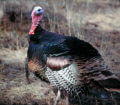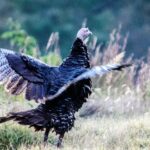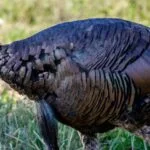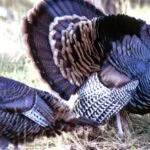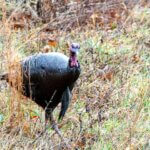John’s Note: Matt Van Cise of Brookville, Pennsylvania, has set the turkey-calling world on fire, winning the World Turkey Calling Championship, the Wild Turkey Bourbon Grand National Championship and other national and regional turkey-calling championships. Van Cise uses MAD calls, is a member of the Mossy Oak Pro Staff and loves to hunt wild turkeys.
I built my turkey-calling reputation using a diaphragm mouth caller. If I’m hunting by myself, I also use a box call every day. I really like the MAD Shady Lady box call (http://www.flambeauoutdoors.com/mad/). I also use a custom box call I’ve carried with me for years. I often use a box call after fly-down time, and after the first hunt is over. I like the realism of the turkey sounds and the amount of volume that comes out of a box call. I also use a friction call throughout the day. I also carry the MAD Super Aluminator because it has a completely-different sound from other friction calls. The Super Aluminator makes a lot of turkeys gobble for me. I also take a wide variety of mouth calls with me when I hunt. Besides all my MAD calls, I usually carry some Denny Gulvas diaphragm calls (https://www.midwestturkeycall.com). Gulvas lives here in Pennsylvania. These diaphragm calls have a completely-different sound than other diaphragm calls, and I use them quite a bit.
On some days, a gobbler only will respond to a certain call. Turkeys are individuals, much like ladies and the shoes they wear. A lady chooses a pair of shoes according to color, style and when and where she wants to wear them. Some ladies will have 100-different pairs of shoes. Turkeys are the same way. On some days, they may want one type of call. On another day, they prefer another type of call. So, you may have to use several-different calls. To find the right call for a gobbler on a particular day, determine how quickly he gobbles back to you after you call. If you want to become a serious turkey hunter, I suggest you carry a wide variety of calls. Let the gobblers tell you what type of call and what sounds to use to get that bird to come to you.
I know many hunters who use a gobble call very effectively. However, I rarely use it, just because I’m not very good at it. I’ve tried a wide variety of gobble calls, and I’m not very good with any of them. I always carry one in my turkey vest, but it’s the last call I use, if none of my other calls will make a turkey gobble. I’m not saying a gobble call isn’t a good call, because it is. I just haven’t learned to use it as effectively as I should. For a locator call, I prefer an owl hooter, a crow call or a coyote howler. The coyote howler doesn’t seem to work as well in the Northeast to make a turkey shock gobble, but I use it quite a bit in the evening if I use it at all.
I’m often asked about the toughest turkey I’ve ever hunted. The truth is, I try not to hunt tough turkeys. I did have one old gobbler I tried to take with a friend of mine. He shot at the gobbler and missed him. I hunted that bird for four seasons and saw him several times, but I never could make him gobble, and he never would come to a call. I don’t spend much time with any one gobbler, but I’ve hunted some turkeys hard over several seasons, and I eventually have taken most of them.
 My whole philosophy of turkey hunting is most of the time there will be 2 or 3 days in the season when a gobbler will come to a call. All you have to do is call to him on the day he wants to come in to you. There’s no way to know the day a turkey really wants to come in, so if you hunt several-different turkeys every day of the season, often one of those turkeys will be ready to come in to the call. That’s why I suggest you have multiple gobblers to hunt.
My whole philosophy of turkey hunting is most of the time there will be 2 or 3 days in the season when a gobbler will come to a call. All you have to do is call to him on the day he wants to come in to you. There’s no way to know the day a turkey really wants to come in, so if you hunt several-different turkeys every day of the season, often one of those turkeys will be ready to come in to the call. That’s why I suggest you have multiple gobblers to hunt.
I grew up hunting turkeys. Most of the property I hunted was hardwood timber, and we had very-few fields in our region. In these areas, I rarely, if ever, saw a turkey out in the fields. The gobblers never seemed to roost in the same tree every night. Those turkeys were really hard to pattern. I found I was better off hunting many different areas and trying to hunt very little in the same place. In that type of hunting, I had to find a lot of turkeys and try and get to the one that wanted to come to the call, on the day I hunted him.
I’m a forester, so I can hunt almost every day, even if it’s only for an hour. Because my job involves being out in the woods every day, I consistently can find gobblers. In the section of Pennsylvania where I live, if the property isn’t posted, a hunter usually doesn’t have a problem getting permission to hunt there. I’m often asked which of the four races of turkeys is the most difficult to hunt. I always answer the Osceola, because it’s difficult to get a place to hunt the Osceola gobbler. I love Merriam’s turkeys, since they gobble at almost any turkey sound you make. I think turkeys are turkeys wherever you find them, but some turkeys are harder to take than others because of hunting pressure and predator pressure.
My best tip for becoming a better turkey hunter is to listen to the turkeys when they gobble. Don’t just listen for what the gobblers are doing. Listen to what the gobblers are telling you to do. For instance, some hunters will go into the turkey woods and yelp 30 times consecutively, and the turkey won’t gobble. I’ll go out and yelp five times. If the turkey doesn’t gobble, I use the cutting call a few times. If the turkey gobbles to the cutting call, I keep using that call to try and bring him into gun range. Whatever sounds the turkey will gobble to are the sounds I use.
 I also recommend that you scout at least as much as you hunt, if not more, and hunt more than you call. You have to spend time scouting and being very observant. Look for scratching where turkeys are feeding. Search for strut zones, which you can determine by seeing where a gobbler drags his wings and leaves marks on a road or opening. You actually may see the turkey strutting in a particular area. Look at fields, and you will see turkeys out there. If you will call from the place that the gobbler wants to be, you drastically will increase your odds for bagging that gobbler.
I also recommend that you scout at least as much as you hunt, if not more, and hunt more than you call. You have to spend time scouting and being very observant. Look for scratching where turkeys are feeding. Search for strut zones, which you can determine by seeing where a gobbler drags his wings and leaves marks on a road or opening. You actually may see the turkey strutting in a particular area. Look at fields, and you will see turkeys out there. If you will call from the place that the gobbler wants to be, you drastically will increase your odds for bagging that gobbler.
To learn more about turkey hunting, check out John E. Phillips’ print, Audible, Kindle and Nook turkey books at https://johninthewild.com/books/#turkey and at www.barnesandnoble.com. You also can download a free Kindle app that enables you to read the book on your iPad, computer or SmartPhone. Too, know more about calling turkeys by going to johninthewild.com/audio-files/ to purchase audio turkey tapes of Lovett Williams, Rob Keck and Chris Kirby, available for download to your SmartPhone, tablet or computer. For a free copy of John E. Phillips’ “The Turkey Gobbler Getter Manual,” go to https://johninthewild.com/free-books/ to download.


